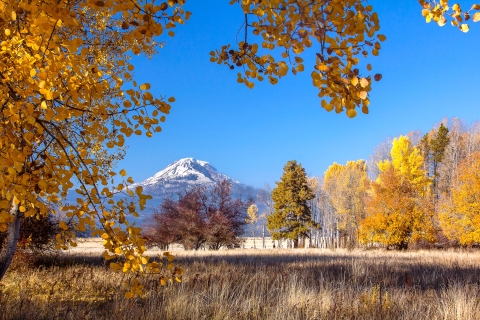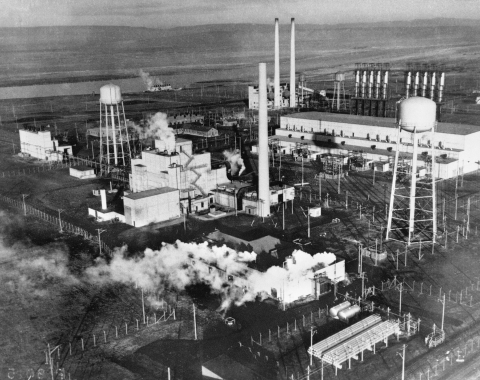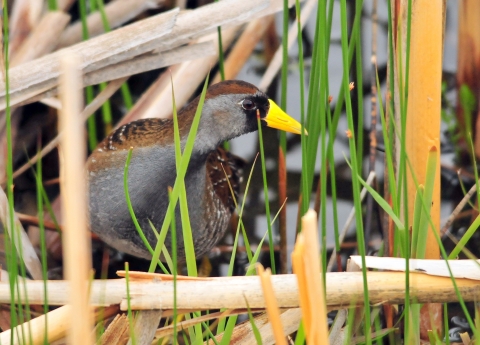Visit Us
From canoeing to hunting, many activities beckon at Columbia National Wildlife Refuge. The refuge is especially known for its birdwatching and fishing. Regardless of the activity, it's a good bet that it was made possible by the Ice Age Floods that reshaped the inland Northwest. Columbia has a host of features, including the Drumheller Channels National Natural Landmark National Natural Landmark
The National Natural Landmarks Program preserves sites illustrating the geological and ecological character of the United States. The program aims to enhance the scientific and educational value of the preserved sites, strengthen public appreciation of natural history and foster a greater concern for the conservation of the nation’s natural heritage. The program was established in 1962 by administrative action under the authority of the Historic Sites Act of 1935. The first National Natural Landmarks were designated in 1963. Today, there are more than 600 National Natural Landmarks in 48 states, American Samoa, Guam, Puerto Rico and the U.S. Virgin Islands.
Learn more about National Natural Landmark . Be sure to check out the National Park Service's brochure.
Trails
Columbia National Wildlife Refuge is a great place to see the power of the ice age floods that ripped the landscape of eastern Washington. The swirling waters and scouring rocks created pockets everywhere, pockets that would later be filled with water from the Columbia Basin Project. The Rimrock Trail is a spectacular vantage point to see the landscape the floods left behind. To see the exposed basalt columns up close, try the Pipistrelle Cliffs at the head of the Black Lake Trail. Here's a MAP to find the trails.
Related Documents
Other Facilities in the Complex
The four refuges that make up the Central Washington National Wildlife Refuge Complex have little in common, other than being in the state of Washington. That makes the Complex a wonderfully diverse blend of habitats, species, and recreational opportunities. There’s something to be found by everyone that will pique their interest or pull them into the landscape. A geology buff? Visit Columbia National Wildlife Refuge, carved by the great floods of the last ice age. Need a scenic landscape to paint or simply unwind in? Conboy Lake is the spot. Interested in our history? The Hanford Reach National Monument is the place to investigate. Want to add to your birding life list? Check the spring and fall migrations through Toppenish.
Conboy Lake National Wildlife Refuge
Nestled near the foot of snow-capped Mount Adams in Washington’s Cascade Range, Conboy Lake National Wildlife Refuge is a scenic gem within the National Wildlife Refuge System. The refuge encompasses 6,574 acres of lush seasonal marshes and vibrant forested uplands that beckon to both visitors and wildlife. A blend of wetlands; grassy prairies; streams; and oak, pine, and aspen forests supports a diverse wildlife community. The rich habitat sustains thriving populations of migrating waterfowl and songbirds. The rare Oregon spotted frog breeds in wetlands throughout the refuge. Elk are plentiful and frequently seen along refuge roads. Conboy Lake also supports most of the breeding population of greater Sandhill cranes in Washington. As a national wildlife refuge national wildlife refuge
A national wildlife refuge is typically a contiguous area of land and water managed by the U.S. Fish and Wildlife Service for the conservation and, where appropriate, restoration of fish, wildlife and plant resources and their habitats for the benefit of present and future generations of Americans.
Learn more about national wildlife refuge , this living system will satisfy your longing for splendor and serenity, just as it did for the indigenous peoples, explorers, loggers, and ranchers who were first drawn to the valley’s plentiful resources.
Hanford Reach National Monument
Thousands of acres of land along the Hanford Reach of the Columbia River and the Saddle Mountain National Wildlife Refuge became the Hanford Reach National Monument in 2000 to protect rare plants, wildlife, and remnants of human history. The 196,000-acre Monument is open, treeless country punctuated by steep rolling hills and canyons. Since 1943, what are now Monument lands have been a safe haven for important and increasingly scarce natural and cultural resources. The lands were allowed to remain wild because they served as a security buffer for the top-secret Manhattan Project during World War II, which produced plutonium for atomic weapons. With limited development and grazing, native plants and animals thrived, and a diverse archaeological record has been preserved. The Monument supports 725 vascular plant species—at least 47 of which are species of conservation concern—42 species of mammals, more than 200 species of birds, 9 reptile and 4 amphibian species, 45 species of fish, and over 1,600 species of insects.
Toppenish National Wildlife Refuge
Toppenish National Wildlife Refuge, established in 1964, is an important link in the chain of feeding and resting areas for waterfowl and other migratory birds using the Pacific Flyway. Although Toppenish was established primarily for migratory waterfowl, many other migratory and resident wildlife species live here, such as American bitterns, peregrine falcons, badgers and beavers. The refuge is a broad collection of habitats supporting a diversity of species. Natural wetlands, such as sloughs and oxbows, and artificial wetlands are flanked by riparian riparian
Definition of riparian habitat or riparian areas.
Learn more about riparian areas. Many species of migratory waterfowl and nongame birds, such as Virginia rails and savannah sparrows, use the wetlands for feeding and nesting activities. Native shrub-steppe—characterized by greasewood, Wyoming big sage, rabbitbrushes, bitterbrush, and native bunchgrasses, such as Great Basin wildrye, Indian ricegrass, Idaho fescue, and Sandberg bluegrass—once covered the upland areas. Loggerhead shrikes, long-billed curlews, California quail, Brewer’s and sage sparrows, and sage thrashers are only some of the animals that use the shrub-steppe. This diverse combination of habitats is a natural magnet to migratory and resident wildlife, alike.
Rules and Policies
Wildlife First! Refuges are places where wildlife comes first. That's why most refuges do not allow activities that cause undue disturbance to wildlife, such as model airplane flying, dog trials, low-flying aircraft, rock climbing, water skiing, off-road driving, snowmobiling, target shooting, and camping.
Did you know that all activities on a national wildlife refuge national wildlife refuge
A national wildlife refuge is typically a contiguous area of land and water managed by the U.S. Fish and Wildlife Service for the conservation and, where appropriate, restoration of fish, wildlife and plant resources and their habitats for the benefit of present and future generations of Americans.
Learn more about national wildlife refuge should be wildlife-dependent? The U.S. Fish & Wildlife Service has identified six such overarching activities—wildlife observation, photography, environmental education, interpretation, hunting and fishing. Keep in mind, if an activity is not wildlife-related and doesn't help in the protection or understanding of wildlife or their habitat, there are probably refuge rules governing this activity. If you are unsure if an activity you hope to pursue is allowed, call the refuge to find out (509-488-2668).
Columbia NWR General Regulations
The refuge is open seven days a week from sunrise to sunset, except for hunting (see below).
Parking is allowed in designated parking areas only. No overnight parking is allowed on the refuge.
The use of unmanned aircraft or drones on the refuge is prohibited.
Camping is no longer allowed on Columbia NWR.
Rock climbing, other than as necessary for allowed activities (e.g., hiking) is prohibited. The use of any gear for assistance (e.g., ropes, carabiners, cams) is prohibited, as are any devices that alter the landscape (e.g., drills).
Littering is unlawful and can seriously injure wildlife. Help keep the refuge clean by removing all trash.
Dogs must be on leash.
No off-road vehicles.
Collecting of plants, animals, minerals, antlers and artifacts is strictly prohibited.
Firearms and other weapons are subject to state law. At all times, persons possessing, transporting, or carrying firearms on the refuge must comply with all provisions of state law. Firearms may only be discharged in accordance with refuge hunting regulations, i.e., only during the lawful pursuit of game during legal seasons.
Columbia NWR Fishing Regulations
Fishing is permitted on the refuge in designated areas and in accordance with state and federal regulations. Check the state fishing regulations for restrictions on individual lakes. To view or download the state fishing regulations, visit the Washington Department of Fish and Wildlife's Fishing web site.
To see refuge-specific regulations and a map, please see our new PDF file—Columbia Fishing Regulations.
Columbia NWR Hunting Regulations
No trapping of any kind is allowed on Columbia NWR.
For the current regulations related to hunting on Columbia NWR, please visit www.fws.gov/mcriver/regulations/.
For the current regulations related to fishing on Columbia NWR, please visit www.fws.gov/mcriver/regulations/.









